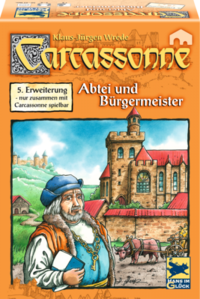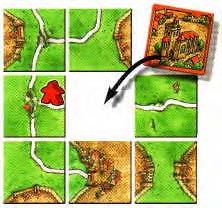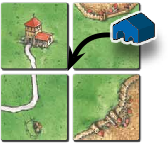Абатството и кметът (Първо издание)
 |
You are reading the rules for this tile design. |
 | Read the following rules if your tiles look like this. |
| If your tiles have a different design, then choose a game from Spin-offs. |  |
General info and comments

Абатството и Кметът (Голямо разширение #5) е първоначлно публикувано от Hans im Glück през 2007
Съдържание
Бележки за някои от обектите по плочките от това разширение:
Правила
Подготовка за игра
В началото на играта получавате по една завършваща плочка - абатство,
по 1 чифлик, 1 кмет и 1 фургон в цвета си. Те се прибавят към свитата.ref>
![]() Официален стату: Кметът и фургонът са последователи, които подлежат на стандартните правила за поставяне и контрол. Чифликът е специална фигура, а не последовател.
</ref>
С изключение на описаните по-долу новости, важат познатите правила.
Официален стату: Кметът и фургонът са последователи, които подлежат на стандартните правила за поставяне и контрол. Чифликът е специална фигура, а не последовател.
</ref>
С изключение на описаните по-долу новости, важат познатите правила.
Поставяне на теренни плочки
Абатството
Подготовка за игра
В началото на играта, всички получават по една плочка Абатство пред себе си.
Поставяне на плочка
Вместо теглене и поставяне на плочка, може да изберете да изиграете своята плочка Абатство. [4]
То може да се постави само на празни места върху картата, където пасва точно една плочка, или иначе казано, в "дупка", заобиколена на кръст (хоризонтално и вертикално) от 4 други плочки.[5] [6] При това няма никакво значение какво е изобразено върху околните плочки - крепости, пътища или друго; всички терени наоколо пасват. Ако няма
такава "дупка", абатството не можеда бъде играно.
Ако един или повече от играчите не са изиграли своята плочка с абатство, когато и последната теренна плочка е изтеглена и изиграна, те все още могат да я изиграят. По посока на часовниковата стрелка, започвайки от играча отляво на на този, който е изиграл последната плочка и спазвайки правилата на поставяне. Тогава играта приключва. [7] [8]
Поставяне на последовател
Може да поставите последовател върху абатството като монах. [9] [10] [11]
Когато поставяте абатство (а също и потенциален михпъл), то трябва да е обрадено от всичките четири страти. [12] [13] [14] След това всички завършени крепости, пътища и манастири се оценяват по стандартния начин. [15] [16]
Точкуване
Монасите в абаствата се оценяват по същия начин като в манастир.
Финално оценяване
Монаси в незавършени абатствта се оценяват както се оценяват в незавършени манастири в края на играта.
Кметът
Подготовка за игра
Всеки играч получава по един кмет в неговия цвят, който се прибавя към свитата му.
Поставяне на плочка
Няма специфични плочки свързани с Кмета, но е важно да се отбележи, че градове с щитова са особени важни за Кмета.
Поставяне на последовател
Кметът може да се играе вместо обикновен мийпъл. Може да се изиграе само в град, в който в моментя няма рицар; [17] [18] [19] [20] [21] важат стандартните правила за игране на мийпъли. [22] [23]
Силата на кмета е равна на броя на гербовете в крепостта - 0 ако няма нито един.
Оценяване
При оценяване на завършени крепости важи следното:
- обикновен мийпъл има сила едно
- големият мийпъл от Страноприемници и Катедрали има сила лдве
The strength of the mayor is the same as the number of pennants in the city. [24] If the city has no pennants, then the mayor has a strength of zero and scores no points for the city. [25] [26] [27] The score of the city is not changed by the mayor. After scoring, the mayor is returned to the player's supply.
Фургонът
Подготовка за игра
Всеки играч получава по един фургон в неговия цвят, който се прибавя към свитата му.
Поставяне на плочка
За фургона няма специфични теренни плочки.
Поставяне на последовател
The wagon may be deployed instead of a normal follower. It may be deployed to a road, city, or cloister in which there is no other figure. [28] [29] [30] [31] The wagon may never be deployed to a field segment.
При оценяване на обект с фургон, той се счита за обикновен мийпъл.
Оценяване
If a feature occupied by a wagon is scored, the wagon counts as a normal follower. After scoring, the player may return the wagon to his or her supply, or may move the wagon to a directly adjacent road, city, or cloister. [32] [33] [34] [35] [36]
The feature into which the wagon is moved [37] must be incomplete and unoccupied. [38] If none of the neighboring features are incomplete and unoccupied, the player must return the wagon to the supply. [39] If several wagons are involved in scoring, then each player decides whether to retrieve or move his or her wagon, beginning with the player whose turn it is and continuing clockwise.
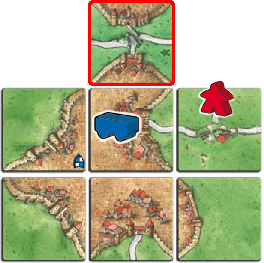
Additional examples
If a wagon is placed in a city completed and scored, the wagon can only move to a road, if this road (uncompleted and unoccupied) is directly adjacent to this city (connected to the city walls through a gate). Since a farm is also an feature, there must be no farm between the road and the city. It does not matter where the wagon is placed within the completed and scored feature (e.g. city) before it moves. Features sharing a surface like an adjacent abbey or a cloister within a city can also be considered as a valid destination for the wagon.
Moving the dragon depends entirely on feature adjacency, not on the initial position of the wagon within the feature completed and scored. Likewise, the wagon can move to any tile of the adjacent feature (the number of tiles the wagon moves is irrelevant).
The following examples illustrate the movement of the wagon in various scenarios.
Example 1. Moving from a completed city
After the city is completed and scored, the wagon moves to an adjacent feature which has to be incomplete and unoccupied.
The city is completed by the surrounding walls and the abbey. The city is adjacent to the several farms, an incomplete road, a short road, and an incomplete abbey. Additionally, there is also an incomplete cloister within the city.
The wagon can move move to:
- The incomplete road (any of its tiles)
- The incomplete abbey
- The incomplete cloister within the city
The wagon cannot move to:
- Any farm adjacent to the city
- Any road not connected to the city through a gate
- The short road connected to the city or any roads connected to it at the junction
- The incomplete road connected to the abbey, since it is not connected directly to the city
- The cloister with the completed road connected to the abbey
- The incomplete city connected through short roads and a junction
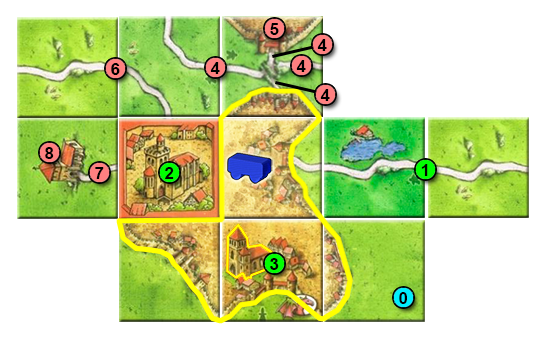
- 0 Tile just placed.
- 1 The wagon can move to this road.
- 2 The wagon can move to this abbey.
- 3 The wagon can move to the cloister within the city.
- 4 The wagon cannot move to the short road ending at the completed city or to any road connected to it through the junction.
- 5 The wagon cannot connect to this city because it is connected through short roads and a junction to the completed city.
- 6 The wagon cannot move to this uncompleted road because it is connected to the abbey, not to the completed city.
- 7 The wagon cannot move to this road because it is completed and connected to the abbey, not to the completed city.
- 8 The wagon cannot move to this cloister because it is directly connected to the completed city; it is connected to a completed road leading to the abbey.
Example 2. Moving from a completed city
After the city is completed and scored, the wagon moves to an adjacent feature which has to be incomplete and unoccupied.
The city is completed by the surrounding walls. The city is adjacent to the several farms and 3 roads. Two roads are completed, so the wagon can only move to the incomplete road at the top.
The tile where the wagon is placed in the city does not affect the possible options. The result is always the same: an adjacent uncompleted unoccupied feature to the city.
Likewise, if the wagon is moved to the incomplete road, it can be placed on any of its tiles.
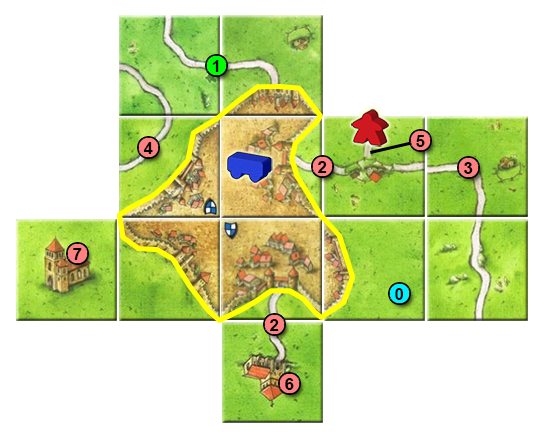
- 0 Tile just placed.
- 1 The wagon can move to this road. It can be placed on any of its tiles.
- 2 These roads are connected to the city but they are completed.
- 3 This road does not border directly at the city wall because it starts at the junction.
- 4 This road does not border directly at the city wall because there is a farm between this road and the completed city.
- 5 This road does not border directly at the city wall because it starts at the junction and it is occupied.
- 6 This cloister is not directly adjacent to the completed city because there is a completed road between the cloister and the completed city.
- 7 This cloister is not directly adjacent to the completed city because it is surrounded by a farm.
Example 3. Moving from a completed road
After the road is completed and scored, the wagon moves to an adjacent feature which has to be incomplete and unoccupied.
The wagon can move to an adjacent feature on any of the road's ends. The number of tiles the wagon moves is irrelevant. It is only important that the feature is directly adjacent to the completed road.
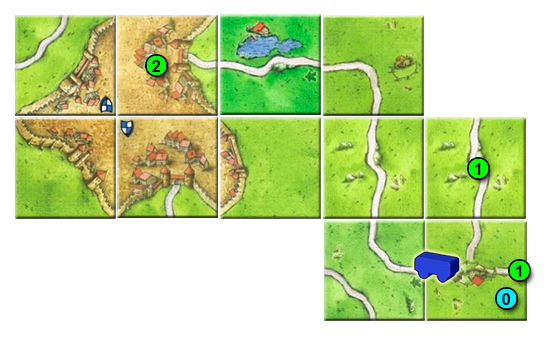
- 0 Tile just placed.
- 1 The wagon can move to any tile of these directly adjacent roads, because they are uncompleted and unoccupied.
- 2 The wagon can move to any of the tiles in the city because it is directly adjacent to the completed road (the city closes its left end), and it is uncompleted and unoccupied.
Чифликът
Подготовка за игра
Всеки играч получава по един чифлик в неговия цвят, който се прибавя към свитата му.
Поставяне на плочка
За чифлика няма специфични теренни плочки.
Поставяне на последовател
The barn may be placed instead of a follower. It may only be placed on the point of intersection of four land tiles, one of which has just been placed by the player. The four land tiles must only consist of fields at this intersection point. [40] [31] [41] [42] [43]
Чифликът може да се пострави и на поляна, където вече има селяни, но не и ако има друг чифлик. [44]
Чифликът ще остане тамн до края на играта. [45]
Чифликъут не може да бъде премахнат от дракона (от Принцесата и Драконът), нито да се вземе като заложник от кула (от Кулата).
Оценяване
Оценяване при поставяне на чифлик
Any farmers already on the farm are scored immediately, in the same way as at the end of the game. [46] [47]
That is, the player or players with the majority of farmers score the usual 3 points for every completed city. [48]
It makes no difference whether the owner of the barn is involved in scoring
or not. [49] When playing with ![]() Exp. 2 - Traders & Builders, a player with a pig scores 4 points per city instead of 3 when scoring points for a farm. Then the players return the farmers (and pigs, if used) to their supply. The barn, however, remains. [50]
Exp. 2 - Traders & Builders, a player with a pig scores 4 points per city instead of 3 when scoring points for a farm. Then the players return the farmers (and pigs, if used) to their supply. The barn, however, remains. [50]
Summary for use with other expansions:
If farmer majority –
- 3 points per completed city adjacent to farm
- 4 points per castle adjacent to farm
- +1 point per castle or completed city with pig (then return pig to owner’s supply)
- +1 point per castle or completed city with pig herd tile
Точкуване при свързване на полянка
No farmer may be deployed to a farm with a barn. [51] If the placement of a tile results in a farm with farmers being connected to a farm with a barn, the farmers are scored immediately. [46] [52] However, the player with the majority of farmers scores only 1 point for every completed city (with a pig: 2 points instead of 1). [53] These farmers (and pigs, if used) are then also returned to their owners after scoring.
Summary for use with other expansions:
If farmer majority –
- 1 point per completed city adjacent to farm
- 2 points per castle adjacent to farm
- +1 point per castle or completed city with pig
- +1 point per castle or completed city with pig herd tile
Финално оценяване
At the end of the game, the owner of a barn scores 4 points for every completed city adjacent to the farm [54]
and 5 points for every castle adjacent to the farm. If several barns lie on a single farm through the placement of connecting tiles, each player receives the full score. The pig-herd tile (from ![]() River II) does not generate any additional points for the barn. [55] [56]
River II) does not generate any additional points for the barn. [55] [56]
Домашни правила
- Wagons are only allowed to be used in cloisters (and shrines) if the tile also contains a road. This means that the wagon cannot be used in an abbey. (Thanks to dwhitworth)
- The wagon can move to the next complete, or uncontested and incomplete, feature. This lets it roll across the board to uncontested features. (Thanks to viberunner)
- The mayor cannot be captured by the tower. (Thanks to viberunner)
- The wagon cannot be eaten by the dragon or captured by the tower. (Thanks to viberunner)
- The wagon can be used in ‘non-roaded’ features. It can move from the abbey to a touching city or road (one move, one turn) but it cannot do so from a cloister that touches only a farm. (Thanks to viberunner)
- The mayor is laid flat in the same way as farmers so that you can tell at a glance which cities contain mayors. (Thanks to Joff)
Разпределение
Бележки
За лицензите на иконите и допълнителни обяснения моля посетете страницата икони.
- ↑
 За плочката с кладенеца и трите пътя всички пътища трябва да се завършят преди оценяване.
За плочката с кладенеца и трите пътя всички пътища трябва да се завършят преди оценяване.
- ↑
 За плочката с трите пътя в Абатството и кметът дължината на пътя (за целите на оценяването на Крадецът) е общият брой на плочки с път, а не най-голямото разстояние между два негови края. Този път има три края за завършване, но това често означава че ще е по-голям от обикновено.
За плочката с трите пътя в Абатството и кметът дължината на пътя (за целите на оценяването на Крадецът) е общият брой на плочки с път, а не най-голямото разстояние между два негови края. Този път има три края за завършване, но това често означава че ще е по-голям от обикновено.
- ↑
 На примерите в това разширение пътят с тунела се брои за "счупен" ако се играе с разширението Тунелът. В този случай плочката се счита зе съдържа две несвързани отвора за тунел.
На примерите в това разширение пътят с тунела се брои за "счупен" ако се играе с разширението Тунелът. В този случай плочката се счита зе съдържа две несвързани отвора за тунел.
- ↑
 Ако все още имате плочката абатство и изтеглите последната плочка, също така я изиграете на обект с майстора-строител, абатството може да се изиграе като втора плочка за двойния ход (преди последния рунд на слагане на плочки с абатство).
Ако все още имате плочката абатство и изтеглите последната плочка, също така я изиграете на обект с майстора-строител, абатството може да се изиграе като втора плочка за двойния ход (преди последния рунд на слагане на плочки с абатство).
- ↑
 The RGG edition clarifies this sentence by adding "(not the diagonals)".
The RGG edition clarifies this sentence by adding "(not the diagonals)".
- ↑
 The rules that restrict the placement of cloisters next to already placed shrines also restrict the placement of abbeys.
The rules that restrict the placement of cloisters next to already placed shrines also restrict the placement of abbeys.
- ↑
 Този парагтраф е добавен в Big Box 2 на HiG’s и RGG и всъщност противоречи на по-ранни ЧЗВ (според които плочките абатство не могат да се изиграят щом и последната теренна плочка бъде изтеглена и изиграна).
Този парагтраф е добавен в Big Box 2 на HiG’s и RGG и всъщност противоречи на по-ранни ЧЗВ (според които плочките абатство не могат да се изиграят щом и последната теренна плочка бъде изтеглена и изиграна).
- ↑
 След като абатство се изиграе по този начин може да се постави мийпъл върху него както обикновено. Ако абатството се завърши то се оценява така както би се оценило в стандартен ход. След това започва крайното оценяване. (5/2013)
След като абатство се изиграе по този начин може да се постави мийпъл върху него както обикновено. Ако абатството се завърши то се оценява така както би се оценило в стандартен ход. След това започва крайното оценяване. (5/2013)
- ↑
 Версията на RGG има известна разлика с това че последното изречение в този параграф е преместено тук.
Версията на RGG има известна разлика с това че последното изречение в този параграф е преместено тук.
- ↑
 Когато се постави абатствто, последовател не може да се постави до него (като рицар, например), тъй катоп то заема цялата плочка. Нищо от околността не е град. Така че последовател на тази плочка може да бъде само монах.
Когато се постави абатствто, последовател не може да се постави до него (като рицар, например), тъй катоп то заема цялата плочка. Нищо от околността не е град. Така че последовател на тази плочка може да бъде само монах.
- ↑
 Светилище може да предизвика абатство и обратно, тъй като абатството е също така и манастир.
Светилище може да предизвика абатство и обратно, тъй като абатството е също така и манастир.
- ↑
 Ако завърщите обект с плочка с абатствои имате майстор-строител в него, обектът the не се разширява с абатството (тъй като то е отделен обект), следователно не теглите нова плочка.
Ако завърщите обект с плочка с абатствои имате майстор-строител в него, обектът the не се разширява с абатството (тъй като то е отделен обект), следователно не теглите нова плочка.
- ↑
 Въпрос: Ако крепост с търговски стоки в него се завърши чрез поставянето на абатство, играчът, който го поставя, получва ли търговските стоки? Отговор: Да, тъй като довършва крепостта.
Въпрос: Ако крепост с търговски стоки в него се завърши чрез поставянето на абатство, играчът, който го поставя, получва ли търговските стоки? Отговор: Да, тъй като довършва крепостта.
- ↑
 Абатството служи и за граница на полянки.
Абатството служи и за граница на полянки.
- ↑
 Рицар в обсадена крепост може да избяга с помощта на абатство, тъй като абатството има всички характеристики на манастир.
Рицар в обсадена крепост може да избяга с помощта на абатство, тъй като абатството има всички характеристики на манастир.
- ↑
 Кметове и фургони също могат да избягат от обсадени крепости чрез манастири и абатста (въпреки че би било забавно кметът да остане като капитан на потъващ кораб).
Кметове и фургони също могат да избягат от обсадени крепости чрез манастири и абатста (въпреки че би било забавно кметът да остане като капитан на потъващ кораб).
- ↑
 Всеки мийпъл, включително и кмет, изигран в крепост се счита за рицар.
Всеки мийпъл, включително и кмет, изигран в крепост се счита за рицар.
- ↑
 RGG изданието на Голямата кутия 2 гласи “нито рицар, нито мийпъл”. В други версии на правилата пише “нито рицар, нито кмет,” нот това е излишно , тъй като кметът е рицар (като всеки друг мийпъл в крепост). (обновено 1/2015)
RGG изданието на Голямата кутия 2 гласи “нито рицар, нито мийпъл”. В други версии на правилата пише “нито рицар, нито кмет,” нот това е излишно , тъй като кметът е рицар (като всеки друг мийпъл в крепост). (обновено 1/2015)
- ↑
 Кметът не може да се изиграе в крепост, в която има фургон. И двете са мийпъли (според дефиницията в правилата), така че крепостта е заета от фургона.
Кметът не може да се изиграе в крепост, в която има фургон. И двете са мийпъли (според дефиницията в правилата), така че крепостта е заета от фургона.
- ↑
 Кметът може да е летец. Може да се приземи само на не завършена крепост. Ако няма такава на плочката, на която се приземи кмета, той се връща обратно в свитата. (2/2013)
Кметът може да е летец. Може да се приземи само на не завършена крепост. Ако няма такава на плочката, на която се приземи кмета, той се връща обратно в свитата. (2/2013)
- ↑
 Кметът може да мине през магически портал. Но може да се изиграе само в незавършена и незаета крепост. (2/2013)
Кметът може да мине през магически портал. Но може да се изиграе само в незавършена и незаета крепост. (2/2013)
- ↑
 Кметът и фургонът могат да бъдат изядени от дракона, пленени от кула или прилъстени от принцеса. Също така могат да се изиграят в съответния квартал на Каркасон. Кметът и фургонът могат да ползват магически портал.
Кметът и фургонът могат да бъдат изядени от дракона, пленени от кула или прилъстени от принцеса. Също така могат да се изиграят в съответния квартал на Каркасон. Кметът и фургонът могат да ползват магически портал.
- ↑
 Въпрос: Могат ли кметът, фургонът и чифликът да се изиграят върху кула? Отговор: Не, игрането на тези фигури е лимитирано до обектите, описани в правилата.
Въпрос: Могат ли кметът, фургонът и чифликът да се изиграят върху кула? Отговор: Не, игрането на тези фигури е лимитирано до обектите, описани в правилата.
- ↑
 The RGG edition inserts the following clarification: “For example, if the city has 3 pennants, the mayor counts as 3 followers.”
The RGG edition inserts the following clarification: “For example, if the city has 3 pennants, the mayor counts as 3 followers.”
- ↑
 The qualification about scoring no points is new in HiG’s
The qualification about scoring no points is new in HiG’s  Big Box 2, and confirms an earlier FAQ.
Big Box 2, and confirms an earlier FAQ.
- ↑
 Question: Blue has a mayor in a city with no pennants. Does the city count as occupied? And if so, when the city is scored, will Blue score points? Answer: The city is occupied. The mayor has no “strength,” so he counts as if there is no follower, and scores no points.
Question: Blue has a mayor in a city with no pennants. Does the city count as occupied? And if so, when the city is scored, will Blue score points? Answer: The city is occupied. The mayor has no “strength,” so he counts as if there is no follower, and scores no points.
- ↑
 A mayor could end up in a castle, and the castle would be considered to be occupied. However, because castles have no pennants (similar to the above footnote), the player would receive no points when the castle was completed, as the strength of the followers in the castle would be 0.
A mayor could end up in a castle, and the castle would be considered to be occupied. However, because castles have no pennants (similar to the above footnote), the player would receive no points when the castle was completed, as the strength of the followers in the castle would be 0.
- ↑
 Instead of "no other figure," this should read "no other follower".
Instead of "no other figure," this should read "no other follower".
- ↑
 The RGG edition changes “figure” to “no other wagon or follower.” This avoids confusion about the term “follower” but adds a distinction between “follower” and “wagon” which is not valid.
The RGG edition changes “figure” to “no other wagon or follower.” This avoids confusion about the term “follower” but adds a distinction between “follower” and “wagon” which is not valid.
- ↑ Cite error: Invalid
<ref>tag; no text was provided for refs namedcan - ↑ Jump up to: 31.0 31.1 Cite error: Invalid
<ref>tag; no text was provided for refs namedtower - ↑
 Question: What is the definition of [connected/adjacent/neighboring] for the Wagon? If two city walls are touching (maybe even only at a point), can I drive my Wagon from one to another? Answer: “Connected” means roads which lead to crossings and roads which head directly “into” a city or a cloister. Two cities never connect to each other (in the current land tiles). City walls that touch at a point (such as at the corner of tiles) are not considered connected, so the wagon cannot travel from one to the other. Thus, the wagon has to use the roads to move. [Additionally, a road that touches a city at a point but not at a gate in the wall is not connected to the city. Also, a road running through a city via a tunnel is not connected to the city. – Chris O.] (confirmed 5/2013)
Question: What is the definition of [connected/adjacent/neighboring] for the Wagon? If two city walls are touching (maybe even only at a point), can I drive my Wagon from one to another? Answer: “Connected” means roads which lead to crossings and roads which head directly “into” a city or a cloister. Two cities never connect to each other (in the current land tiles). City walls that touch at a point (such as at the corner of tiles) are not considered connected, so the wagon cannot travel from one to the other. Thus, the wagon has to use the roads to move. [Additionally, a road that touches a city at a point but not at a gate in the wall is not connected to the city. Also, a road running through a city via a tunnel is not connected to the city. – Chris O.] (confirmed 5/2013)
- ↑
 The wagon cannot move directly from one city to the other on the tile shown above. There is a crossing between the two cities, and crossings belong to roads. Thus, for the wagon to move through the crossing, it would have had to have started on a road. The cities are not directly connected from wall to wall. The wagon cannot move to one of the “small roads”, either, as the rules clearly state that followers cannot be placed there. (8/2013)
The wagon cannot move directly from one city to the other on the tile shown above. There is a crossing between the two cities, and crossings belong to roads. Thus, for the wagon to move through the crossing, it would have had to have started on a road. The cities are not directly connected from wall to wall. The wagon cannot move to one of the “small roads”, either, as the rules clearly state that followers cannot be placed there. (8/2013)
- ↑
 The wagon cannot drive through any feature to get to another feature. Features are any aspect of the tile that can be claimed by a follower or that triggers a function, including cloisters, bazaars, crop circles, fairs, etc. [Note: this represents a reversal of a previous clarification. Previously, unclaimable structures such as fairs were not considered features and could be driven through to a road on the other side.] (5/2013)
The wagon cannot drive through any feature to get to another feature. Features are any aspect of the tile that can be claimed by a follower or that triggers a function, including cloisters, bazaars, crop circles, fairs, etc. [Note: this represents a reversal of a previous clarification. Previously, unclaimable structures such as fairs were not considered features and could be driven through to a road on the other side.] (5/2013)
 This means that the wagon cannot drive through any special thing on a tile, including the School.
This means that the wagon cannot drive through any special thing on a tile, including the School.
- ↑
 A wagon can be placed on an abbey. Additionally, the wagon can drive onto a directly connected city or road after scoring (and the other way round, from city/road to abbey), as long as the target feature has not yet been completed. (confirmed 5/2013)
A wagon can be placed on an abbey. Additionally, the wagon can drive onto a directly connected city or road after scoring (and the other way round, from city/road to abbey), as long as the target feature has not yet been completed. (confirmed 5/2013)
- ↑
 The wagon can be moved from a city to a cloister that is within that city (or vice versa), as roads are not required for a “connection,” just a shared wall/edge/surface. (confirmed 5/2013)
The wagon can be moved from a city to a cloister that is within that city (or vice versa), as roads are not required for a “connection,” just a shared wall/edge/surface. (confirmed 5/2013)
- ↑
 When moving a wagon to a new feature, the player can choose which tile to set it on. For example, if moving the wagon from a city to a road which so far consists of five tiles, the wagon can be placed on any of those tiles, not just the first tile that it gets to. For scoring this doesn't matter, but if a dragon or the plague happens to come by, the exact placement will make a big difference.
When moving a wagon to a new feature, the player can choose which tile to set it on. For example, if moving the wagon from a city to a road which so far consists of five tiles, the wagon can be placed on any of those tiles, not just the first tile that it gets to. For scoring this doesn't matter, but if a dragon or the plague happens to come by, the exact placement will make a big difference.
- ↑
 The RGG version adds the following clarification: "A wagon always counts as though it were a follower during scoring."
The RGG version adds the following clarification: "A wagon always counts as though it were a follower during scoring."
- ↑
 Question: Can you deploy a wagon to a city, score it, and then move the wagon to another feature, all in one turn? Or can you only move the wagon instead of deploying a normal follower? Answer: The wagon can be deployed instead of a normal follower. If the city is immediately completed, then it’s scored (wagon or “normal” follower). After scoring, the wagon can be moved. All of that is possible in a single turn. [Wagon movement is not in place of deployment.]
Question: Can you deploy a wagon to a city, score it, and then move the wagon to another feature, all in one turn? Or can you only move the wagon instead of deploying a normal follower? Answer: The wagon can be deployed instead of a normal follower. If the city is immediately completed, then it’s scored (wagon or “normal” follower). After scoring, the wagon can be moved. All of that is possible in a single turn. [Wagon movement is not in place of deployment.]
- ↑
 The barn cannot be placed in the City of Carcassonne. The barn cannot use a magic portal.
The barn cannot be placed in the City of Carcassonne. The barn cannot use a magic portal.
- ↑
 The barn can be placed on a tile with a volcano.
The barn can be placed on a tile with a volcano.
- ↑
 The fairy cannot be placed next to the barn, as the barn is not a follower.
The fairy cannot be placed next to the barn, as the barn is not a follower.
- ↑
 The barn cannot be placed at an intersection with mist banks, since they separate fields.
The barn cannot be placed at an intersection with mist banks, since they separate fields.
- ↑
 В RGG изданието липсва последното изречение за другите чифлици.
В RGG изданието липсва последното изречение за другите чифлици.
- ↑
 Въпреки това чифлика може да бъде премахнат чрез Фестивална плочка. (12/2014)
Въпреки това чифлика може да бъде премахнат чрез Фестивална плочка. (12/2014)
- ↑ Jump up to: 46.0 46.1
 The word “immediately” here means that farmers are scored then removed during the normal scoring phase of this turn (as opposed to staying on the farm until the end of the game). The placement of a barn does not stop play for a separate scoring phase for the farmers. Thus, the normal “move wood” portion of the turn occurs before the farmers are scored. (10/2012)
The word “immediately” here means that farmers are scored then removed during the normal scoring phase of this turn (as opposed to staying on the farm until the end of the game). The placement of a barn does not stop play for a separate scoring phase for the farmers. Thus, the normal “move wood” portion of the turn occurs before the farmers are scored. (10/2012)
- ↑
 Placing of a barn, and the subsequent scoring of the farm, does count as an opportunity to remove a follower from Carcassonne. Now that farms can be scored at times other than at the end of the game, followers from the market can be moved to farms earlier in the game. That occurs immediately after the placement of the barn, and before the farmers are scored. [Joining of a farm containing a follower to a farm with a barn would logically be another opportunity – Chris O.]
Placing of a barn, and the subsequent scoring of the farm, does count as an opportunity to remove a follower from Carcassonne. Now that farms can be scored at times other than at the end of the game, followers from the market can be moved to farms earlier in the game. That occurs immediately after the placement of the barn, and before the farmers are scored. [Joining of a farm containing a follower to a farm with a barn would logically be another opportunity – Chris O.]
- ↑
 A besieged city does still score double points if it lies on a farm with a barn.
A besieged city does still score double points if it lies on a farm with a barn.
- ↑
 Question: If I place a barn on a farm on which another player has farmers, causing him/her to score while I score nothing, can I move a follower to Carcassonne? (While there is no immediate score to me now, the barn is certain to score at the end of the game). Answer: Yes, that’s allowed. Only immediately scored points matter.
Question: If I place a barn on a farm on which another player has farmers, causing him/her to score while I score nothing, can I move a follower to Carcassonne? (While there is no immediate score to me now, the barn is certain to score at the end of the game). Answer: Yes, that’s allowed. Only immediately scored points matter.
- ↑
 The RGG edition added this last sentence.
The RGG edition added this last sentence.
- ↑
 The RGG version further clarifies this as follows: "There may only be one barn on each farm. Of course, connecting two farms, each with a barn, is quite legal."
The RGG version further clarifies this as follows: "There may only be one barn on each farm. Of course, connecting two farms, each with a barn, is quite legal."
- ↑
 Because this joining of farms is a scoring situation, a follower can be moved from Carcassonne to the farm with a barn. The farmer will be scored immediately, and so scores only 1 point per city and is (importantly) not on the farm during the final scoring proper.
Because this joining of farms is a scoring situation, a follower can be moved from Carcassonne to the farm with a barn. The farmer will be scored immediately, and so scores only 1 point per city and is (importantly) not on the farm during the final scoring proper.
- ↑
 Question: May the pig be placed on a farm that was just connected to a farm with a barn, i.e. on the newly placed tile (immediately before scoring)? Answer: Yes, the pig may be placed in already occupied features [and, as above, the normal “move wood” phase still happens].
Question: May the pig be placed on a farm that was just connected to a farm with a barn, i.e. on the newly placed tile (immediately before scoring)? Answer: Yes, the pig may be placed in already occupied features [and, as above, the normal “move wood” phase still happens].
- ↑
 The RGG edition adds "regardless of their distance from the barn". This is probably to help introduce players to 3rd edition scoring.
The RGG edition adds "regardless of their distance from the barn". This is probably to help introduce players to 3rd edition scoring.
- ↑
 The last sentence is new to the
The last sentence is new to the  Big Box 2 and confirms an earlier FAQ. The statement is not in
Big Box 2 and confirms an earlier FAQ. The statement is not in  Big Box 3, presumably because
Big Box 3, presumably because  River II is not included in this collection.
River II is not included in this collection.
- ↑
 The pig-herd tile can score an extra point per city when there is a barn on the farm.
The pig-herd tile can score an extra point per city when there is a barn on the farm.
